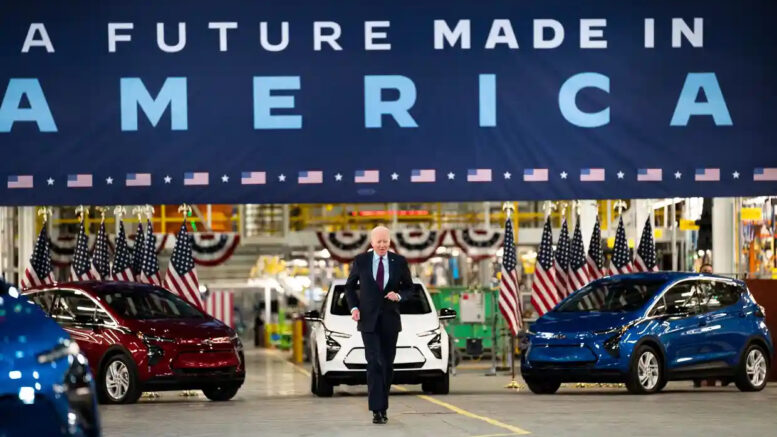By Nina Lakhani
The US transition to electric vehicles could require three times as much lithium as is currently produced for the entire global market, causing needless water shortages, Indigenous land grabs, and ecosystem destruction inside and outside its borders, new research finds.
It warns that unless the US’s dependence on cars in towns and cities falls drastically, the transition to lithium battery-powered electric vehicles by 2050 will deepen global environmental and social inequalities linked to mining—and may even jeopardize the 1.5C global heating target.
But ambitious policies investing in mass transit, walkable towns and cities, and robust battery recycling in the US would slash the amount of extra lithium required in 2050 by more than 90 percent.
In fact, this first-of-its-kind modeling shows it is possible to have more transport options for Americans that are safer, healthier and less segregated, and less harmful mining while making rapid progress to zero emissions.
The research by the Climate and Community Project and University of California, Davis, shared exclusively with the Guardian, comes at a critical juncture with the rollout of historic funding for electric vehicles through Joe Biden’s Inflation Reduction and Infrastructure Investment and Jobs Acts.
The harms of ‘white gold’
The global demand for lithium, also known as white gold, is predicted to rise over 40 times by 2040, driven predominantly by the shift to electric vehicles. Grassroots protests and lawsuits against lithium mining are on the rise from the US and Chile to Serbia and Tibet amid rising concern about the socio-environmental impacts and increasingly tense geopolitics around supply.
The US’s affinity for cars, especially big ones, and sprawling cities and suburbs where driving to work, school and shop is often the only option, gives its transition to electric vehicles major global significance.
No matter what path it chooses, the US will achieve zero emission transportation by 2050, according to the research. But the speed of the transition—as well as who benefits and who suffers from it—will depend on the number and size of electric vehicles (and batteries) Americans opt for going forward.
“Preserving the status quo might seem like the politically easier option, but it’s not the fastest way to get people out of cars or the fairest way to decarbonize,” said Thea Riofrancos, associate professor of political science at Providence College and lead author of the report.
“We can either electrify the status quo to reach zero emissions, or the energy transition can be used as an opportunity to rethink our cities and the transportation sector so that it’s more environmentally and socially just, both in the US and globally.”
“The report brings into light possibilities for a future without fossil fuels that minimizes mineral extraction and new harms to communities in lithium-rich areas,” said Pía Marchegiani, policy director at the Environment and Natural Resources Foundation in Argentina.
Transportation is the biggest source of carbon emissions in the US—and the only sector in which emissions are still rising—making it crucial to phase out gas and diesel vehicles as quickly as possible to limit the climate breakdown.
Biden’s strategy to fully decarbonize the transportation sector by 2050 puts some focus on mass transit and land-use planning, but so far the messaging—and funds—have been geared toward encouraging Americans to swap gas-guzzling cars for electric vehicles rather than change the way they travel.
It’s working: over half of the nation’s car sales are predicted to be electric by 2030, and states like New York and California have passed laws phasing out the sale of gas cars.
This is good news but there’s a catch: lithium.
Electric vehicles are already the largest source of demand for lithium—the soft, white metal common to all current rechargeable batteries.
Mining lithium is a fraught business, and the rise in demand for EVs is contributing to a rise in social and environmental harms—and global supply chain bottlenecks.
If Americans continue to depend on cars at the current rate, by 2050 the US alone would need triple the amount of lithium currently produced for the entire global market, which would have dire consequences for water and food supplies, biodiversity, and Indigenous rights.
But it doesn’t have to be this way, according to the report Achieving Zero Emission Transportation With More Mobility and Less Mining.
Best scenarios
Researchers created a novel modeling tool to compare the amount of lithium needed to achieve zero transport emissions for personal vehicles (cars, trucks and SUVs) under different scenarios. It’s the first study to project future lithium demand based on variables like car ownership, battery size, city density, public transit and battery recycling, and connect this with avoidable harms.
In each scenario, the US achieves zero emission transportation by 2050 and in each case some additional lithium mining will be needed.
How much lithium depends on policy decisions taken now, according to the report, impacting economic prosperity, public health, environmental justice, ecosystems and communities at every part of the supply chain for decades to come.
In the best-case scenario—comparing the status quo in which EV battery size grows and US car dependency remains stable—with ambitious public transit, city density and recycling policies, the lithium demand would be 92 percent lower. (Battery size, like the size of a fuel tank, dictates range —or how far you can travel before having to recharge.)
But results show that even if Americans can’t wean themselves off cars with big lithium batteries, increasing the density of metropolitan areas and investing in mass transit would cut cumulative demand for lithium between 18 and 66 percent. Limiting the size of EV batteries alone can cut lithium demand by up to 42 percent by 2050.
Source: theguardian.com, January 24, 2023

